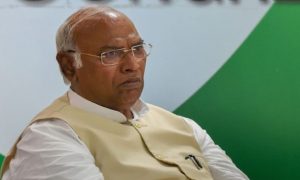The government is also considering allowing employees to invest more than 40% of the NPS corpus in systematic withdrawal plans and inflation-indexed products to boost their pension incomes.
With some Opposition-ruled states announcing plans to reintroduce the old defined-benefit pension scheme (OPS) for their staff and discard the reform-oriented contributory national pension system (NPS), the Union government may recommend annuitisation of entire government contribution towards NPS as an alternative.
The government is also considering allowing employees to invest more than 40% of the NPS corpus in systematic withdrawal plans and inflation-indexed products to boost their pension incomes.
Under NPS, 60% of the accumulated corpus from contributions during a person’s working years is allowed to be withdrawn at the time of retirement. Such withdrawal is also tax-free. The balance 40% is invested in annuities, which according to an estimate, could provide a pension equivalent of about 35% of last pay drawn. Under OPS, government employees used to get 50% of the last salary drawn as pension.
If 60% of the contribution, which roughly corresponds to the contribution by Centre/state government, is annuitised, the pension in NPS can be close to 45% of last drawn salary. The 5% gap can be bridged by the government concerned by contributing a little more to NPS. This is seen to be a much better alternative than bringing back the unsustainable OPS model, an official source said. The employees will also have the option to withdraw the corpus out of their own contribution entirely at the time of exit.
Recently, the finance ministry said in a reply to a question in Parliament that a government employee could also provide her entire contribution towards NPS for annuitisation, which could increase the pension income to above 50% of last salary drawn.
Since FY20, the Central government staff has been eligible for deduction of 24% of salary (employees’ contribution of 10% and employers’ share of 14%) for NPS contributions and as many as 15 state governments have subsequently enhanced employers’ share to NPS to 14%.
In its budget for FY23, Rajasthan announced a plan to restore the old pension system for all state government employees from the next financial year and Chhattisgarh followed suit. If implemented, this could also increase their fiscal burden.
After the Centre rolled out the NPS for all its new employees from January 1, 2004, most big states made it mandatory for their employees in 2004 or 2005, with Rajasthan joining on January 1, 2004, and Chhattisgarh on November 1, 2004. Both these states were ruled by either the BJP or the Congress over these years. In Tamil Nadu, the ruling DMK had announced ahead of state assembly polls in early 2021 that it will restore OPS. But the DMK government hasn’t unveiled the scheme so far, apparently in view of budget constraints. Tamil Nadu manages its NPS corpus independently, while other states’ pension funds are under fund managers appointed by the pension regulator.
As of February 28, 2022, about 5.5 million state government employees were enrolled under NPS with assets under management (AUM) of Rs 3.61 trillion. There are about 2.27 million central government employees in the scheme with AUM of Rs 2.15 trillion.
NPS returns are far better than what other superannuation funds offer. For example, the government-sector subscribers have got over 10% return in FY22 under NPS against 8.1% under EPFO and around 8% given by a couple of superannuation funds run by insurance companies, the schemes that give close competition to NPS.
“OPS makes future generations pay for the pensions. There is the risk of governments defaulting on its payment obligations given its unsustainability, whereas NPS has a real corpus that will provide for a definite pension,” said Gautam Bhardwaj, co-founder of pinBox, a global pension-tech committed to digital micro-pension inclusion in Asia and Africa.
According to a report by Old Age Social and Income Security Project, the implicit pension debt (IPD) of the country — central (civil) employees, state government employees and the funding gap of the Employees’ Pension Scheme, 1995 – worked out to be 64.51% of GDP in nominal terms in 2004. Of course, the actual IPD or the net present value of these future promises would have been much higher if defence pension liability was included.
“Even today, pension liabilities on account of OPS of the Centre and states are off-balance sheet liabilities and it has grown since 2004,” Bhardwaj said.
The pension bill will continue to rise till all the employees joined before January 1, 2004, in the Central government and most big state governments before April 1, 2005, retire from service. Thereafter, the pension liability will reduce substantially as employees who joined after the stipulated date are funded via contributory NPS and won’t need budget support.
“With the life expectancy increasing, pension burden is rising and will continue for another two decades till the employees entitled for OPS retire. Going back to the OPS will exert further pressure on state finances in the long term,” India Ratings chief economist DK Pant said.
The institutional measures adopted by the state governments (such as Fiscal Responsibility and Budget Management Acts, Value Added Tax) and NPS have helped them consolidate their finances in the last decade. Barring a few exceptional years such as FY21, when Covid-19 led to a sudden increase in revenue expenditure, states have managed to keep their fiscal deficit around the prudent level of 3% of GSDP in the last one decade.
Fixed overheads in the form of establishment expenditure (largely towards salaries, wages and bonuses and pensions) account for more than 50% combined revenue expenditure of states.
Despite demand from employee unions, the Centre categorically told Parliament recently that it won’t reintroduce OPS. “If a subscriber feels the need for a higher pension, he/she is free to choose a higher percentage of the corpus (up to maximum 100%) to be utilised for purchase of annuity, which will further provide higher pension amount,” the Union finance ministry had said.



































